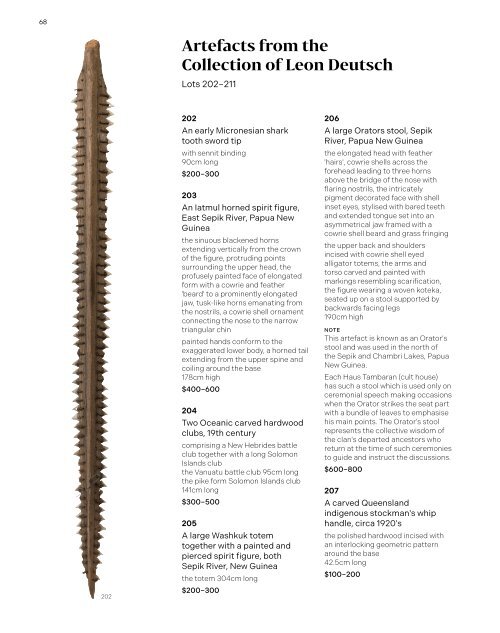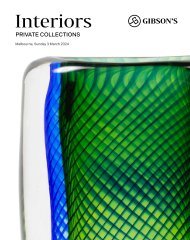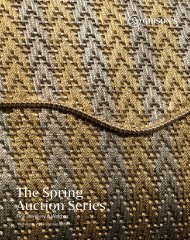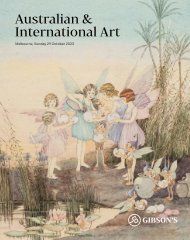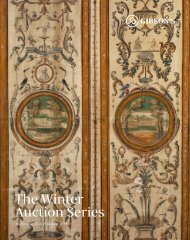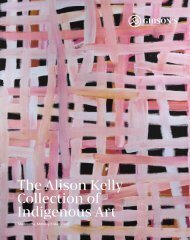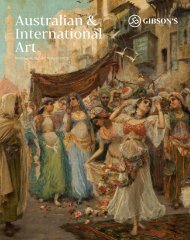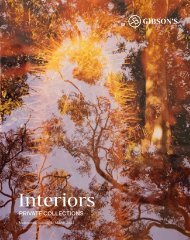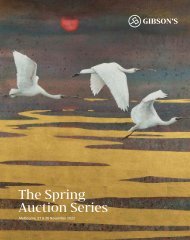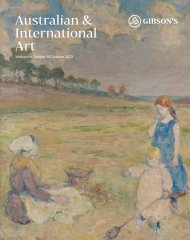GA047-cat-flipbook-v1
ibson’s is delighted to announce our forthcoming Australian, Maritime & Exploration auction featuring items of Australian historical interest and importance including Australian and Colonial Furniture, Decorative Arts, Paintings and Early Photography, Scrimshaw, Artefacts, Goldfields and Convict interest, Militaria, Books and Documents. Leading the sale is the exquisite Australian silver cake clock, commissioned by the Myer Emporium in celebration of the Centenary of Melbourne in 1934, made by renowned silversmiths, Steeth & Son, of Melbourne Cup fame. At almost five kilograms of silver, this example is twice the size of the model in the collection of the National Gallery of Victoria and presents a unique opportunity for private collectors and institutions to acquire a piece of significant Victorian history.
ibson’s is delighted to announce our forthcoming Australian, Maritime & Exploration auction featuring items of Australian historical interest and importance including Australian and Colonial Furniture, Decorative Arts, Paintings and Early Photography, Scrimshaw, Artefacts, Goldfields and Convict interest, Militaria, Books and Documents.
Leading the sale is the exquisite Australian silver cake clock, commissioned by the Myer Emporium in celebration of the Centenary of Melbourne in 1934, made by renowned silversmiths, Steeth & Son, of Melbourne Cup fame. At almost five kilograms of silver, this example is twice the size of the model in the collection of the National Gallery of Victoria and presents a unique opportunity for private collectors and institutions to acquire a piece of significant Victorian history.
Create successful ePaper yourself
Turn your PDF publications into a flip-book with our unique Google optimized e-Paper software.
68<br />
Artefacts from the<br />
Collection of Leon Deutsch<br />
Lots 202–211<br />
202<br />
202<br />
An early Micronesian shark<br />
tooth sword tip<br />
with sennit binding<br />
90cm long<br />
$200–300<br />
203<br />
An Iatmul horned spirit figure,<br />
East Sepik River, Papua New<br />
Guinea<br />
the sinuous blackened horns<br />
extending vertically from the crown<br />
of the figure, protruding points<br />
surrounding the upper head, the<br />
profusely painted face of elongated<br />
form with a cowrie and feather<br />
'beard' to a prominently elongated<br />
jaw, tusk-like horns emanating from<br />
the nostrils, a cowrie shell ornament<br />
connecting the nose to the narrow<br />
triangular chin<br />
painted hands conform to the<br />
exaggerated lower body, a horned tail<br />
extending from the upper spine and<br />
coiling around the base<br />
178cm high<br />
$400–600<br />
204<br />
Two Oceanic carved hardwood<br />
clubs, 19th century<br />
comprising a New Hebrides battle<br />
club together with a long Solomon<br />
Islands club<br />
the Vanuatu battle club 95cm long<br />
the pike form Solomon Islands club<br />
141cm long<br />
$300–500<br />
205<br />
A large Washkuk totem<br />
together with a painted and<br />
pierced spirit figure, both<br />
Sepik River, New Guinea<br />
the totem 304cm long<br />
$200–300<br />
206<br />
A large Orators stool, Sepik<br />
River, Papua New Guinea<br />
the elongated head with feather<br />
'hairs', cowrie shells across the<br />
forehead leading to three horns<br />
above the bridge of the nose with<br />
flaring nostrils, the intri<strong>cat</strong>ely<br />
pigment decorated face with shell<br />
inset eyes, stylised with bared teeth<br />
and extended tongue set into an<br />
asymmetrical jaw framed with a<br />
cowrie shell beard and grass fringing<br />
the upper back and shoulders<br />
incised with cowrie shell eyed<br />
alligator totems, the arms and<br />
torso carved and painted with<br />
markings resembling scarifi<strong>cat</strong>ion,<br />
the figure wearing a woven koteka,<br />
seated up on a stool supported by<br />
backwards facing legs<br />
190cm high<br />
NOTE<br />
This artefact is known as an Orator's<br />
stool and was used in the north of<br />
the Sepik and Chambri Lakes, Papua<br />
New Guinea.<br />
Each Haus Tambaran (cult house)<br />
has such a stool which is used only on<br />
ceremonial speech making occasions<br />
when the Orator strikes the seat part<br />
with a bundle of leaves to emphasise<br />
his main points. The Orator's stool<br />
represents the collective wisdom of<br />
the clan's departed ancestors who<br />
return at the time of such ceremonies<br />
to guide and instruct the discussions.<br />
$600–800<br />
207<br />
A carved Queensland<br />
indigenous stockman's whip<br />
handle, circa 1920's<br />
the polished hardwood incised with<br />
an interlocking geometric pattern<br />
around the base<br />
42.5cm long<br />
$100–200


